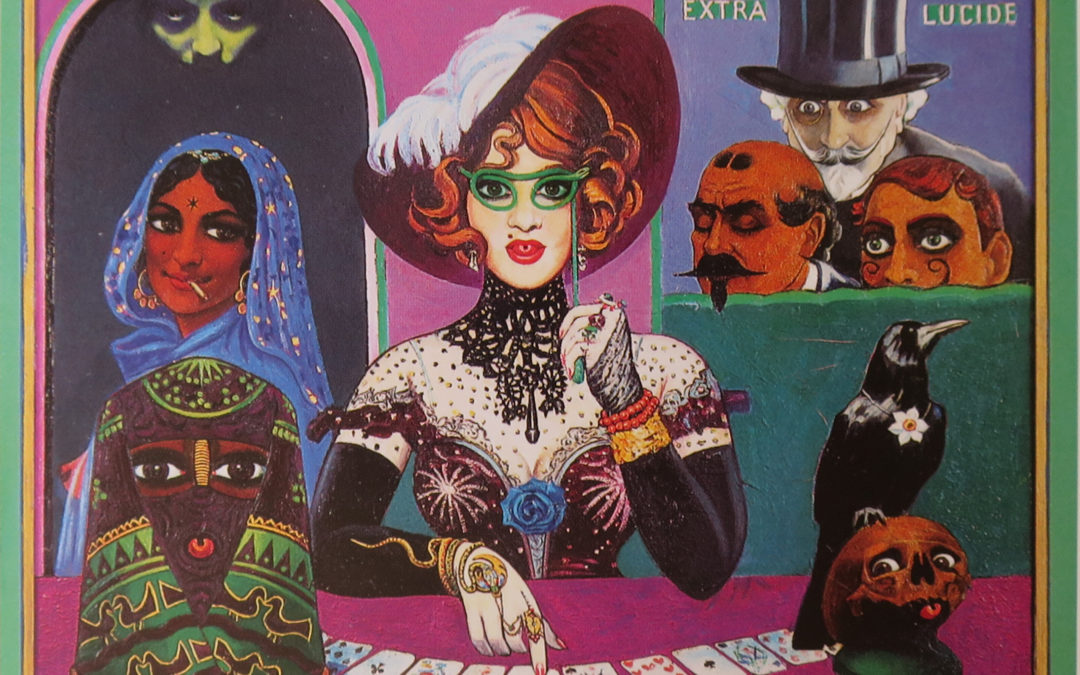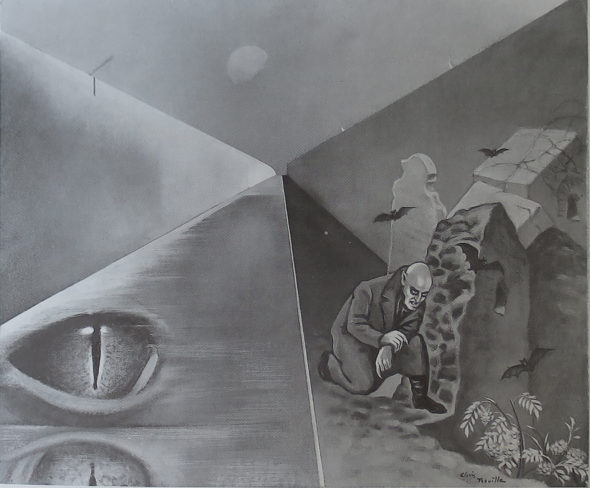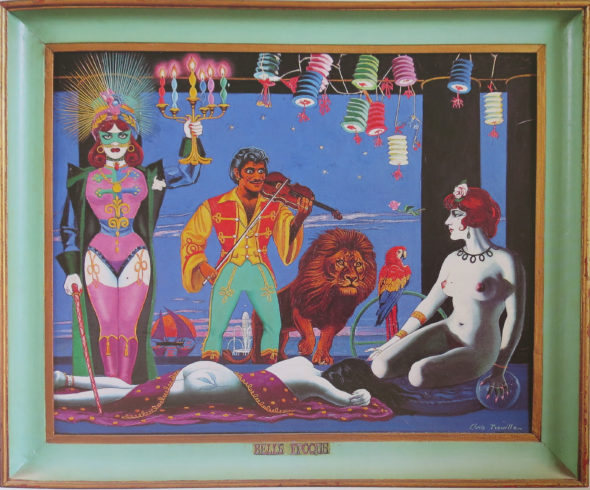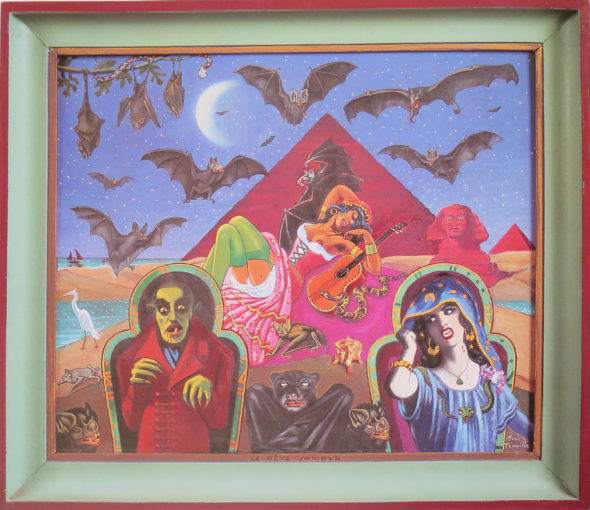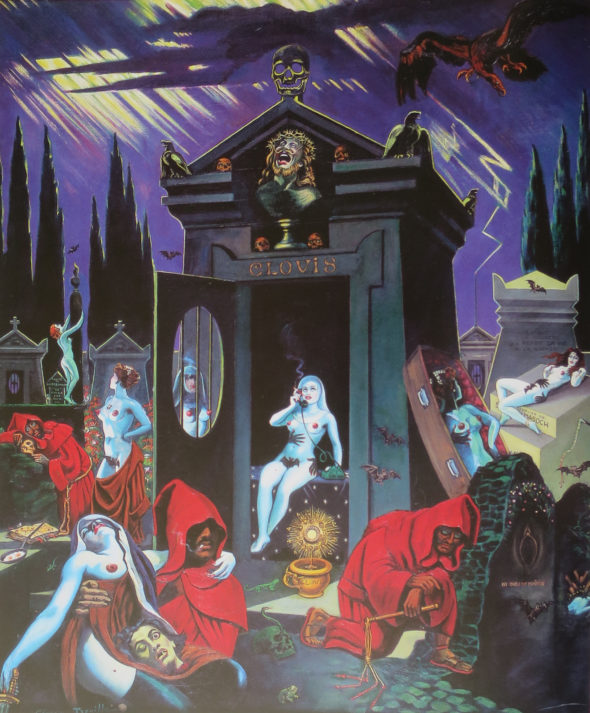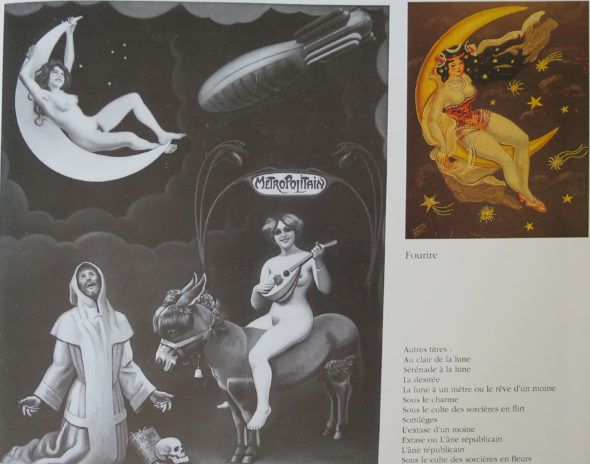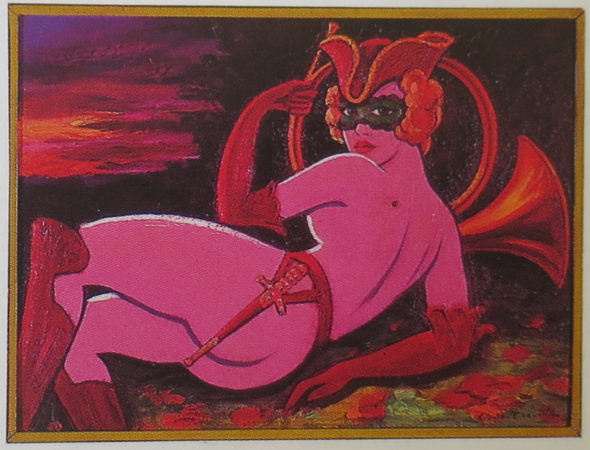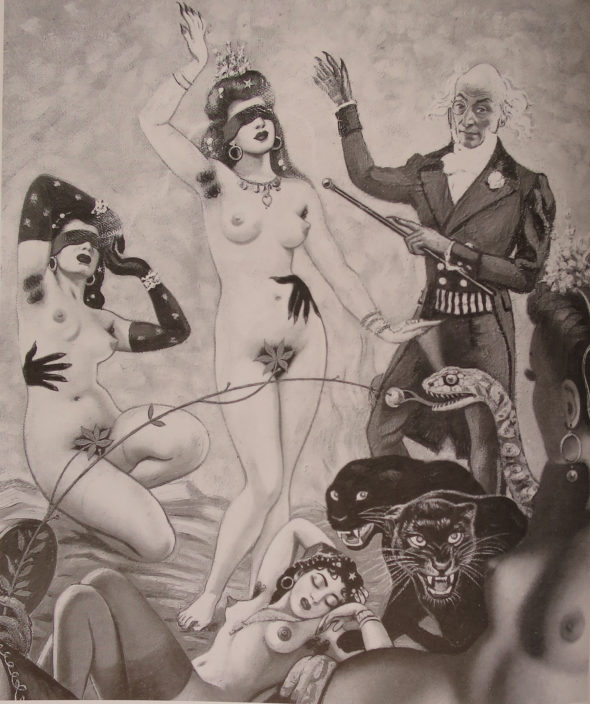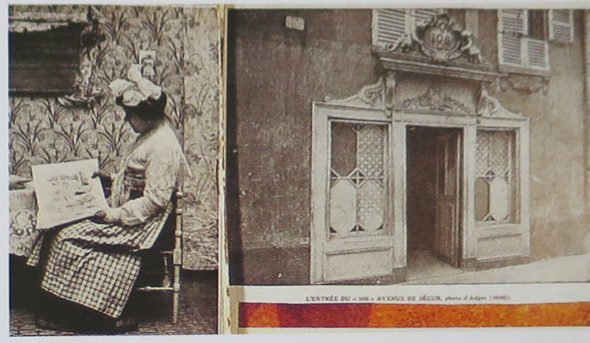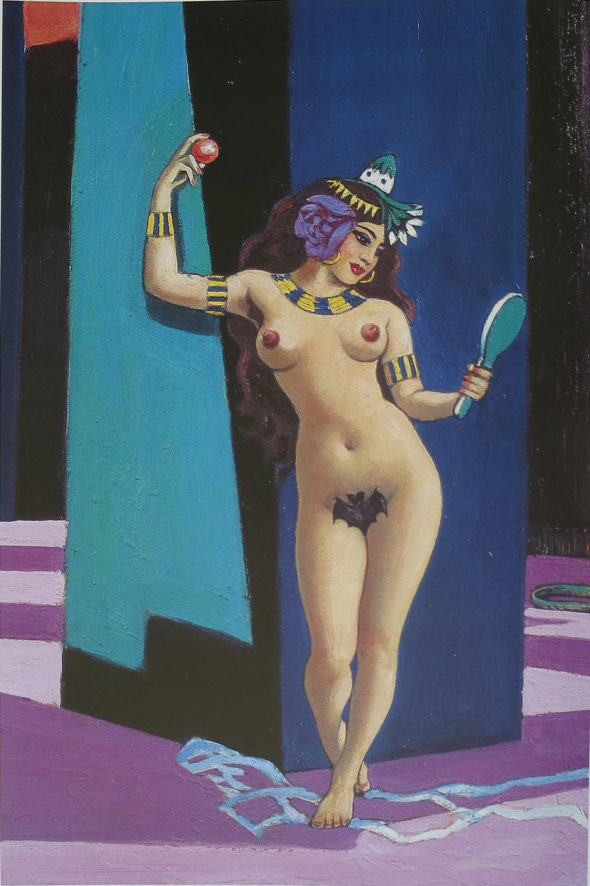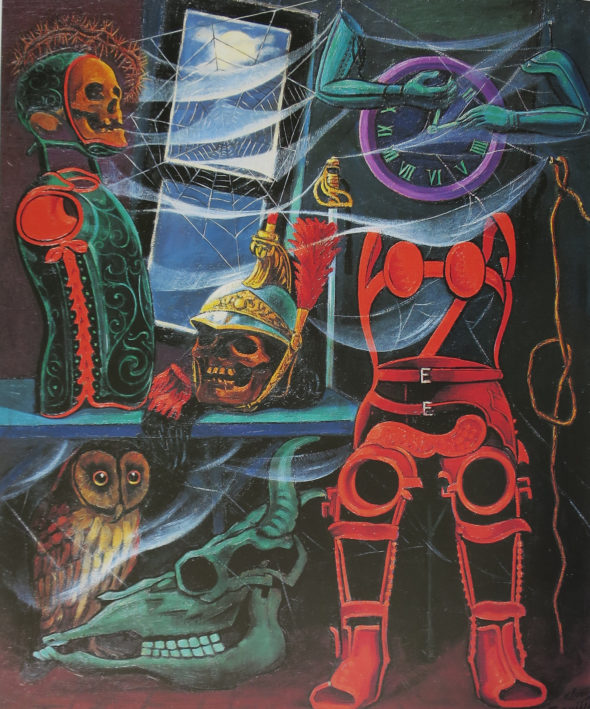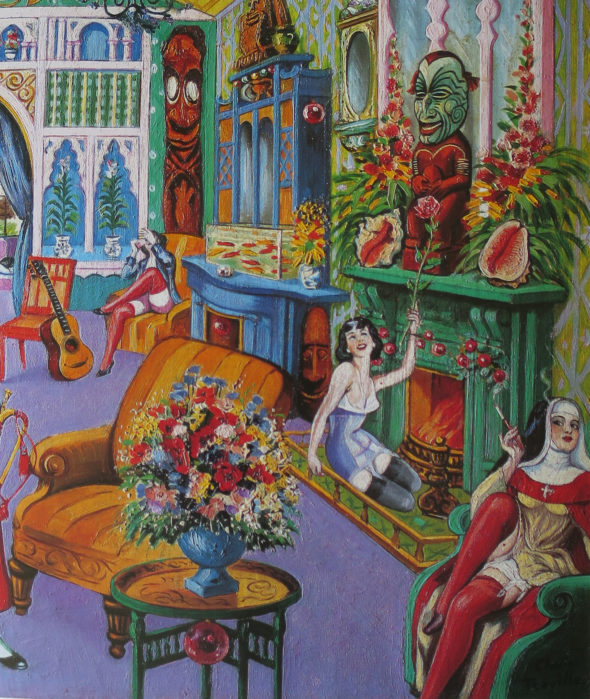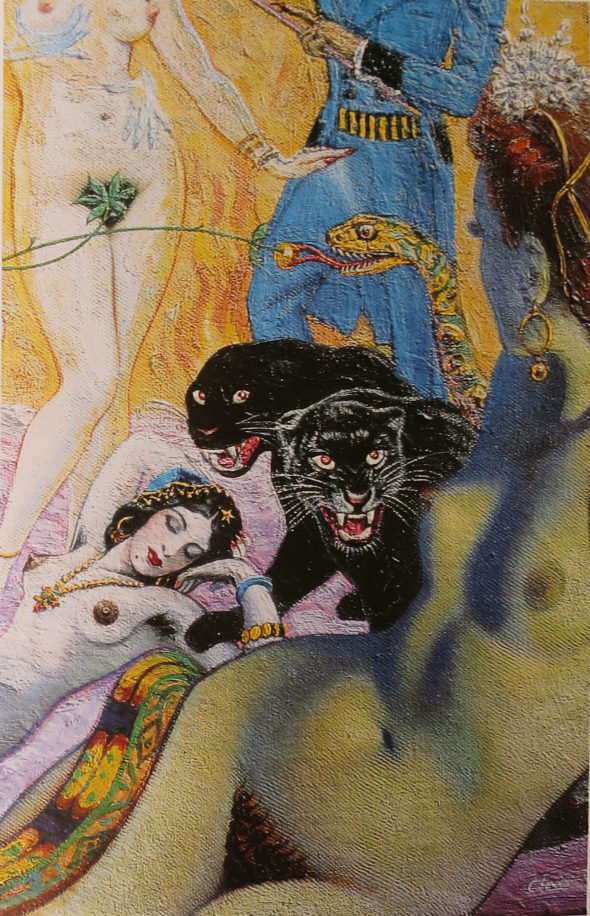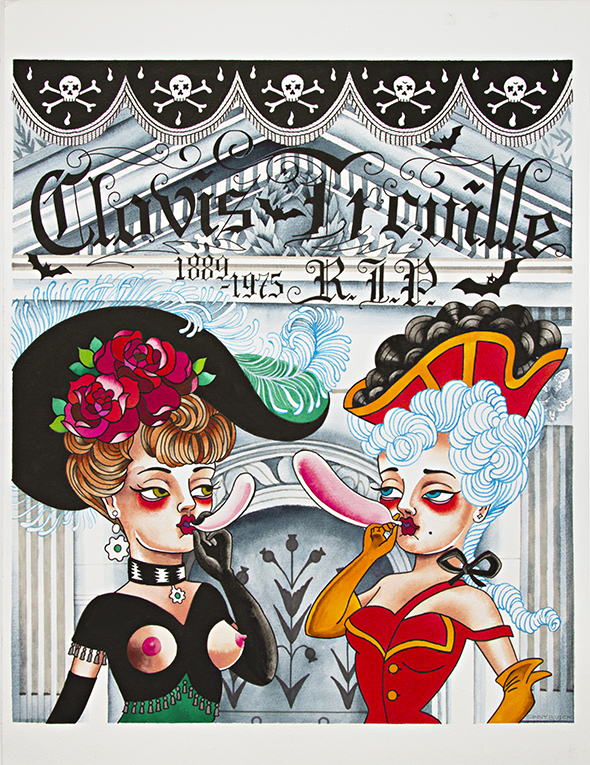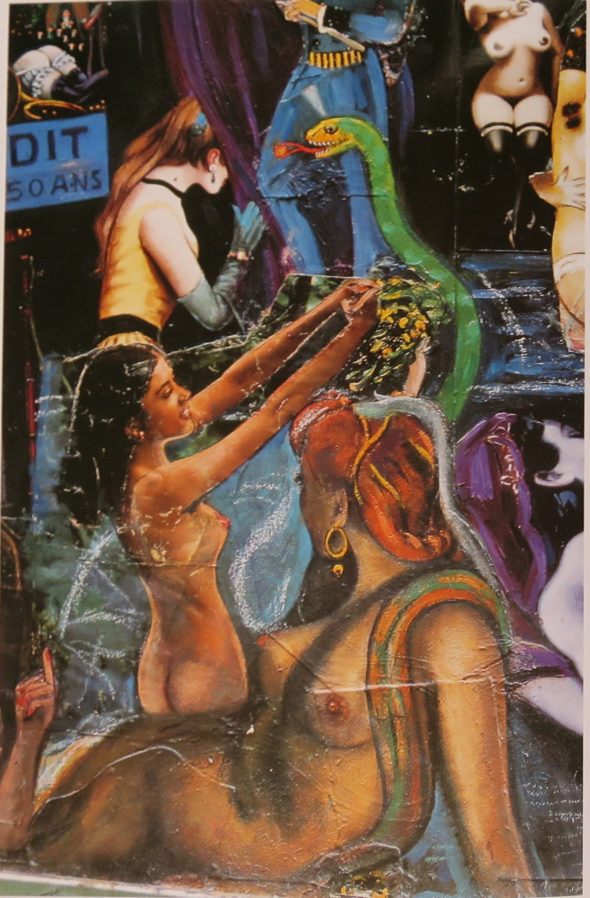I am the spiritual grand-daughter of Clovis Trouille, the French painter known for his vibrant, unconventional subjects that challenged societal norms. He drew inspiration from primal and anarchistic themes, like the carnal appetites of sailors and prostitutes at the bal populaire, the hypocrisy of the clergy, and death and horror.
He mined popular culture and historical imagery to depict his life in his era and his place within it. I myself have followed a similar path. My work, much like his, is a reflection of my environment, a certain irreverence and desire to express my disdain for convention, at the same time, leave behind artifacts for future generations. By juxtaposing seemingly unrelated motifs, I seek to uncover new meanings and provoke alchemic reactions in the viewer’s mind. I’m sure that my spiritual grandfather felt the same.
There are many shared elements between Clovis Trouille’s art and my own. From collage composition to the ongoing evolution of paintings. We both draw inspiration from the gypsy fortune teller, popular culture magazines, and a wide array of motifs including fireworks, tattoos, burlesque, and religious imagery. We are both inspired by Egyptian themes, Tikis, and dark humour. It’s evident that my creative journey intersects with Trouille’s in multifaceted ways. Humour, independence, influenced by popular culture, and a rebellious spirit are central to both of our works. Like Trouille, I challenge societal norms and question the status quo through my art. My use of vivid colors, the eclectic mix of symbols, and the blending of cultures echo Trouille’s style.
Clovis Trouille, deeply affected by his experience in World War I, boldly challenged societal norms by exposing the hypocrisy of the church and the stark divide between the wealthy elite and the poor. His paintings, such as a smoking nun in red stockings, kissing beguines, and a miniskirted bishop, clearly reflect his anger, irreverence, and desire to provoke. In the era he created them, these works were even more shocking.
In a filmed interview, Trouille, dressed in a suit and tie, eloquently expressed his approach to art, noting how he was satisfied just painting only on Sundays. He found the process sublime after contemplating his work all week. He also explained that he got some advice about how to avoid paying a gallery commission, by selling directly to collectors.
On my first trip to Paris I went to the Oceanic Arts museum and found there the catalog to Clovis Trouille’s retrospective. Having already seen his some of his work in my research on Surrealism, immediately, upon seeing more of his work, I recognised a sort of kinship. This artwork touched me deeply, inspired me. After that trip, my dream to moving to Paris intensified, so I packed up and went.
The catalog that I bought and brought home, revealed to me his working process with archives of photo references and sketches. It showed how he would modify or rework old paintings until he was satisfied. Like Trouille, I create my compositions through collage, employing bold colors and kitsch elements to convey hidden emotions and beliefs.
I find his art amusing, his colors bright. I enjoy his sense of humor and his dark side. His graphic style is balanced between naive and sophisticated.
Trouille means «fear» in French and he often used imagery from horror films or dark fictions. Ravens on skulls, bats and vampires, snakes, owls, and spiderweb covered mausoleums. By exploring his own family name, he entertained his fascination or concern with fear and death. Working through his trauma with art.
He was, like me, interested in exploitation films, kitsch, and popular culture. He painted images of Irma Vep from «Les vampires», and scenes from «Cabinet of Dr. Caligari». I myself have used my love of Cinema in some of my works, like « Cinéma Forain »
Max Ernst, influenced both Trouille and I. You can see a direct reference in this painting:
Max Ernst’s collage of a masked woman leaving a mausoleum, juxtaposed with a gallant gentleman rescuing a damsel in distress from a threatening deluge, bears an intriguing resemblance to Clovis Trouille’s work, where a naked nun uses Clovis’s tomb as a telephone booth amid a Bacchanalian scene in a cemetery. The influence of Ernst’s collages on Trouille is evident, particularly in shaping Trouille’s distinctive compositional style. Max Ernst’s “Une Semaine de Bonté,” a collection of 100 images collaged from late 19th-century illustrated novels, serves as a significant reference point. The recurring motif of women sleeping in “Une Semaine de Bonté” resonates with both artists, symbolizing desire and dreams, and reflecting a shared fascination with subconscious themes and surrealist imagery. Trouille’s exploration of these motifs adds layers of meaning that parallel the complexity of human emotions and desires. This connection underscores the depth of his artistic heritage and its influence on my own creative journey, because I am also influenced by Max Ernst. It is from Ernst that I picked up my collage composition style.
Through this shared ethos and creative process, I feel a profound connection to Trouille’s legacy. His influence on me has been great. Discovering his artistic process granted me the permission and freedom to modify and reimagine old works. Our shared influences bridge time and space, I see connections in my artistic vision with his legacy which are unexpected and surprised me.
He was a lone wolf, he was considered a surrealist by Andre Breton but didn’t adhere to the group. Having myself participated in the Californian Lowbrow art scene, yet still feeling like an outsider, I imagine Trouille being accepted by all the kooks and weirdos of that movement. Yet I’m sure that he wouldn’t care and would go on doing his thing. I hope I can live up to this ideal that he has set for me. (If you don’t know much about the Lowbrow art movement, see my video «Eyecandy Bulimia» on YouTube.)
Our shared love for the bizarre and the macabre, coupled with a playful yet critical approach creates a dialogue between our works. My art, in conversation with Trouille’s, is not just a visual experience but a commentary on the absurdities of life, a celebration of the unconventional, and a testament to the power of imagination to defy limitations.
In many ways, I like to think that I carry forward Trouille’s legacy, not just in the themes and techniques I embrace, but in the audacity to remain true to my vision, no matter how unconventional it may be. I am the spiritual grand-daughter of Clovis Trouille, not merely through his artistic influence on me but through a shared commitment to using art as a means of expression, resistance, and liberation.
His decision to bypass galleries and sell directly to collectors is proof of his independent spirit, dedication to his craft, and refusal to conform. Despite being considered a surrealist by some, Trouille remained aloof, less celebrated than figures like Henri Rousseau, yet his impact on the art world was no less significant.

